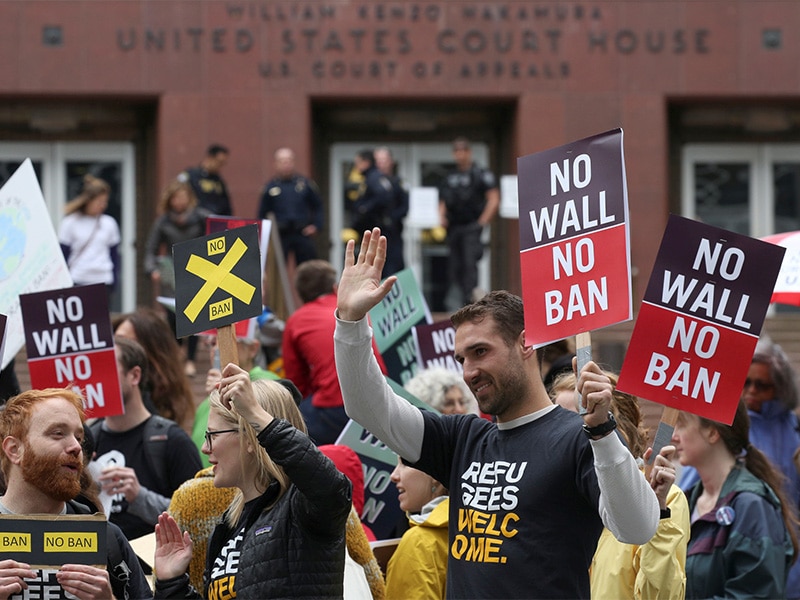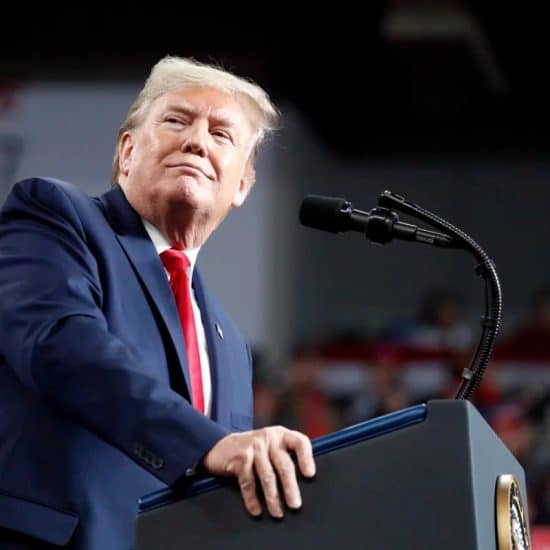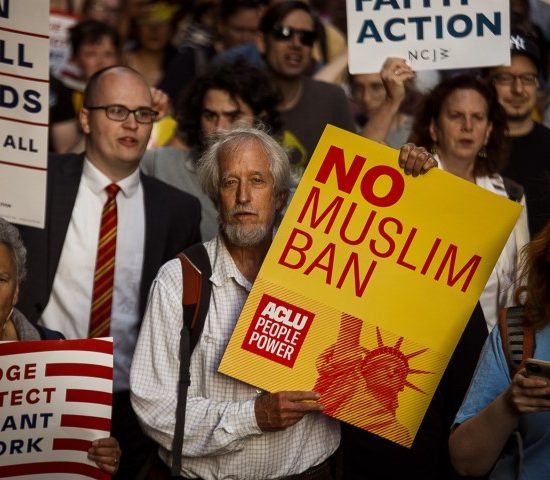WASHINGTON (USA Today) — The long and winding road to the Supreme Court for President Trump’s travel ban may require yet another detour as the White House prepares to revise or replace it.
The administration is planning to add additional countries to a list of nations whose citizens’ travel to the United States would be banned or restricted, an official familiar with the matter said Friday (Sept. 22).
 People protest President Trump’s second travel ban outside of the U.S. Court of Appeals in Seattle on May 15, 2017. Photo courtesy of Reuters/David RyderThe official, who is not authorized to comment publicly, said the added nations would likely be subject to a range of restrictions, but not an all-out ban, based on their inability to adequately screen passengers traveling to the U.S.
People protest President Trump’s second travel ban outside of the U.S. Court of Appeals in Seattle on May 15, 2017. Photo courtesy of Reuters/David RyderThe official, who is not authorized to comment publicly, said the added nations would likely be subject to a range of restrictions, but not an all-out ban, based on their inability to adequately screen passengers traveling to the U.S.
Changes to the system have been under consideration for weeks in preparation for the looming expiration of a 90-day travel ban for countries in the Middle East and North Africa. The latest development was first reported Friday by The Wall Street Journal.
The legal case, long sought by Trump and immigration officials after a series of defeats in federal courts from Maryland to Hawaii, is scheduled to be heard Oct. 10. But the ban on travelers from six Muslim-majority countries expires Sunday, and the White House is expected to announce what happens next.
Trump indicated the direction the administration may be headed in a characteristic tweet following an explosion on an underground train in London last week.
“The travel ban into the United States should be far larger, tougher and more specific,” he said.
The travel ban into the United States should be far larger, tougher and more specific-but stupidly, that would not be politically correct!
— Donald J. Trump (@realDonaldTrump) September 15, 2017
Any change in the terms of the ban — already Trump's second version, after the first was tossed out by the courts — presumably would require the justices to adjust the schedule. They could require more briefing from both sides, send the case back to lower courts or even declare it moot.
That would be a letdown for both sides after eight months of controversy that began with chaos at U.S. airports and resulted in two executive orders, a series of lower court decisions blocking implementation and several Supreme Court interventions. At last count, more than 70 groups have weighed in before the court, mostly backing the ban's challengers.
“This may turn out to be a big dud,” said Martin Lederman, a Georgetown University Law Center professor who has predicted for months that the case would reach a dead end. “The most likely resolution here is no resolution at all.”
Trump originally targeted travelers from seven countries for 90 days and all refugees for 120 days in order to give officials time to review visa and vetting procedures. Revisions later reduced the number of countries to six and allowed for exceptions for legal permanent residents and people who already had visas. The refugee ban extends into late October.
The travel ban finally went into effect June 26 after the Supreme Court allowed a scaled-down version. The justices ruled that travelers from Iran, Libya, Somalia, Sudan, Syria and Yemen could bypass the ban if they could prove they had a "bona fide" relationship with a U.S. person or organization.
Some conservatives say the administration should be content to sideline the legal case, since the latest Supreme Court decisions let the bans on travelers and refugees go into effect with slight revisions.
Challengers representing travelers who have faced a ban on entry to the U.S. want the case to proceed, at least for now, said Omar Jadwat, director of the American Civil Liberties Union's immigration rights project, who has argued the case in lower courts.
If the administration expands the list of affected countries and targets only certain travelers, immigration groups that have protested the travel restrictions from day one likely will challenge those initiatives. So one way or another, a legal challenge would loom that's likely to make its way back to the nation's highest court.
“There’s almost a certainty that the case is going to come back to the court sooner or later,” said Kannon Shanmugam, an appellate lawyer and frequent Supreme Court litigator.



